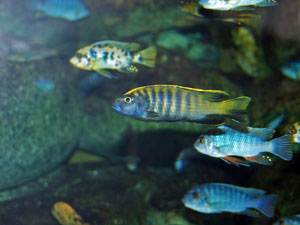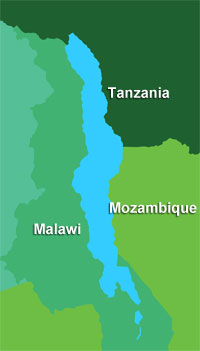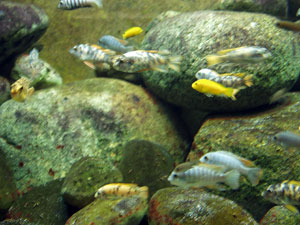

The majority of aquarists first experience of fishkeeping is with a community tank holding several peaceful, but often quite different species, generally from entirely different parts of the world. But this is not the only kind of community aquarium possible. Many bodies of water contain fish communities that co-exist, and are suitable for replication in an artificial aquarium environment. Lake Malawi is one such example; and although not an ideal tank for beginning aquarists, can offer a very satisfying and visually appealing project for the more advanced aquarist. Cichlids come from all over Africa, but when people talk of African Cichlids, they are most likely referring to the species that hail from Lake Malawi and Lake Tanganyika.

Whether you've made up your mind, and you know you want to set up a tank for Malawi cichlids, or you're still not sure, it is important to learn a little about the species you might keep; the lake contains different zones, inhabited by different fish that may not co-exist in the confines of an aquarium. Setting up a tank specifically designed for the needs of your cichlids is important; the fish will be happier and healthier because they are in an aquarium that is designed to look and feel just like their natural habitat. In order to do this, however, you'll need to learn about the lake itself and the different types of fish that live within.

Lake Malawi (also known as Lake Nyasa or Niassa) is one of the freshwater great lakes of the East African rift valley. It is located between Malawi, Mozambique and Tanzania. At almost 600km long, and up to 700m deep it is the third largest and second deepest lake in Africa, and the ninth largest lake in the world. This lake is home to over 1000 species of cichlids, many of which are commonly available in pet stores, or from specialist cichlid breeders; your Lake Malawi aquarium biotope aquarium can have an incredible diversity of life. It is thought that the huge number of cichlid species in Lake Malawi are due to just few common ancestors being temporarily isolated in smaller pools and evolving on different lines. Many are very closely related.
The water in this lake is different than that of many other lakes around the world, which is important to keep in mind while setting up and maintaining your aquarium. It is slightly alkaline, having a pH ranging between 7.7 and 8.6. It also has a carbonate hardness of 107 to 142 mg, which should be maintained in your aquarium (don't worry, it is not too hard to regulate these levels). Located just South of the Equator, the weather is quite warm year around, leading to water temperatures ranging from 24 to 26 degrees Celsius, and dropping as low as 22 degrees at the lower depths of the lake.
Lake Malawi has several distinct environments throughout the lake, and each one has different species of fish. A typical Malawi biotope aquarium will represent one of these zones, although depending on the size of your aquarium, it may be possible to set up more than one of these zones as well.

With so much species variability in one lake it is hard to be absolute on the characteristics of any fish grouping - but there are certain useful generalisations that can be made - be careful to look up any potential new tank dweller just in case it is one of those exceptions.
As with other community aquariums, it is often possible to select fish which live at the bottom, middle and top of the tank, ensuring there is a lot of activity throughout the aquarium, while still avoiding any overcrowding
The relatively shallow rocky shore area contains the mbuna cichlids - these are the best-known Malawi cichlids. They are brightly coloured, territorial, and must be kept in high density to spread out aggression. They are mouthbrooders, and although caves are not required for spawning, they are essential to create territories and provide hiding places. Their diet consists predominantly of algae, and small crustaceans. In captivity they must have a vegetarian component to their diet. Commonly kept mbuna cichlids include Melanochromis johanni, Melanochromis auratus, Melanochromis cyaneorhabdos, Pseudotropheus lombardoi, Pseudotropheus crabro, Metriaclima (Maylandia) estherae, Maylandia callainos, and Labidochromis caeruleus.
As the shoreline gives way to open water, a deeper intermediate zone neither truly rocky, nor completely sandy is the home to the less aggressive peacock cichlids (such as Aulonocara jacobfreibergi). These fish are related to the mbunas, but will not do well in an mbuna tank. These fish can be found at depths of up to 40m.
Many members of the Haplochromis group live in open water. The utakas live in the middle strata; these include species from the Copadichromis (eg Copadichromis borleyi) and Mchenga genera. Sand cichlids also live in open water, but prefer the lower strata. These fish often predate on other smaller cichlids. Due to this potential for predation, and the fact that they do not have easy hiding places, open water Malawi cichlids tend to be less conspicuously coloured than mbunas until fully grown.
Some other haps are less confined to one zone or strata. Species such as the ambush predators of the Nimbochromis genus (eg Nimbochromis venustus) and the sand sifting Cyrtocara moorii tend to roam to a greater degree. These large species tend to be best left for impressive public aquariums.
A tank for African cichlids should be at very least 4 feet long, preferably bigger. You'll want to give yourself several days to prepare your aquarium before adding any fish. This time will be used to set everything up, plan the decor, get the temperature and pH to acceptable levels and let the tank settle. After this initial period, adding one or two fish to 'test the waters' is acceptable. If these first couple fish do well, you can begin adding additional fish, keeping to normal standards for the number of total fish based on the size of your aquarium and the type of filtration you are using. The following items are important for setting up a tank for Malawi cichlids:
OK, you've decided what zone to replicate, you've got your tank set up, the water up to the proper temperature, and passing normal chemical and pH tests, and you're ready to add in some fish and plants. This is, by far, the most enjoyable part of the initial setup, but it shouldn't be rushed. It is far better to slowly introduce fish to the aquarium, and allow them to adjust. Over the course of several weeks, or even months, you can bring your aquarium up to capacity without risking loses. This cycling process is required for all aquariums, but is especially important for cichlids as, they will push the tanks filtration capabilities more than a typical community tank.
Live plants are a great addition to any aquarium. They can help to maintain the water quality, they are especially pleasing to look at, and they provide excellent hiding places for the fish. They can even be food for some species, though this is likely not to be your intention! Lake Malawi has several different types of plants growing around it, but due to the water depth and rocky shoreline perhaps less than other typical cichlid environments. Few native Lake Malawi plant species are commercially available, though one genus that is common is Vallisneria, or eel grass. As previously mentioned Mbuna cichlids dig, and will typically uproot most plant species, however tough-leaved low light level epiphytes such as Anubias and Java Fern can be made to grow on rockwork, and can even thrive.
There are hundreds of different types of Malawi cichlids to choose from, and getting the right mix is important. Some of them are extremely easy to care for, and others are much more difficult. In addition to just choosing the right fish, you also have to make sure you're choosing fish that can live together without too much trouble. It would be impossible to list every detail to consider about every fish native to this incredible lake, so instead, look at the profile of each species you might consider. You can then read about the individual species you're interested in, and find out which ones will work in your aquarium. One of the best first mbunas might be Melanochromis johanni or Johann's Mbuna, as it is hardy, and less aggressive than most Malawi cichlids.
There are several catfish species endemic to Lake Malawi, most notably Synodontis njassae; a very attractive catfish in its own right. Other species include Bagrus and Clarius catfish, though these are large and predatory; certainly not suitable for the home aquarium. Other hardy African and South American catfish will also work: other Synodontis species, Plecostomus, and bristlenose Ancistrus have all been kept in Malawi tanks with great success.
Hardy shoalers, such as rainbowfish are sometimes suggested as dither fish for rift lake tanks, and whilst they can work with cichlids from Lake Tanganyika, Malawi tanks do not need them if stocked properly, and the rainbowfish will be far happier in their own tank!
Setting up a tank for Malawi cichlids is not difficult, but neither is it simple or inexpensive. There is an amount of research that needs to be done over and above keeping a few guppies in a 2 foot tank. But it is a highly rewarding option for any fish or aquarium enthusiast. There are different options available, which can make this type of tank look and feel exactly the way you want. In addition, many of the fish from this lake have stunning colours and extraordinary behaviour, allowing your tank to have an exotic look everyone will enjoy. With a little planning and hard work, you can have a beautiful Malawi cichlid aquarium that you can enjoy for years to come.